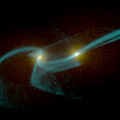CXC Home | Search | Help | Image Use Policy | Latest Images | Privacy | Accessibility | Glossary | Q&A
Q&A: Milky Way Galaxy
Q:
I have heard that the Andromeda Galaxy and the Milky Way Galaxy may end up colliding with each other in the future. What will happen to these two galaxies if this collision occurs?
A:
This collision won't happen for several billion years, but if it does, enormous numbers of new stars should form, as gas from the two galaxies is squeezed together. Large numbers of massive stars should explode as supernovas, spreading heavy elements like iron and magnesium outwards. An example of this effect can be seen in the Antennae galaxies. Chandra observations of these colliding galaxies have revealed hot gas containing extremely high concentrations of heavy elements.
These elements were created by fusion reactions in the centers of massive stars, and were dispersed by supernova explosions.
The motions of the stars in the original spiral galaxies are radically changed by a galactic collision, and eventually a large elliptical galaxy should form. This process is believed to have taken place a few billion years ago in NGC 4261. This large elliptical galaxy shows no trace of its violent history in optical images, but Chandra observations are thought to show remnants of a galactic collision.




